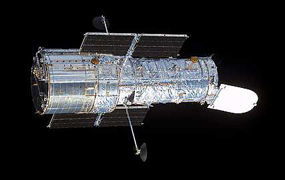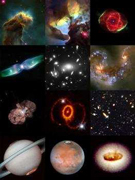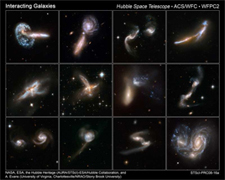Fact Sheet
STS-125 MISSION SUMMARY
SPACE SHUTTLE ATLANTIS (STS-125)
OCTOBER 2008
SPACE SHUTTLE ATLANTIS (STS-125)
OCTOBER 2008
Space shuttle Atlantis’ upcoming 11-day mission is the final shuttle flight to NASA’s Hubble Space Telescope. Five spacewalks are planned to install new instruments and thermal blankets, repair two existing instruments, refurbish subsystems and replace gyroscopes and batteries. The result will be six working, complementary science instruments with capabilities beyond what is now available, and an extended operational lifespan through at least 2013. The seven-member crew will enhance the observatory and ensure cutting-edge science. It puts in place advanced technology that improves the discovery power of Hubble by 10 to 70 times.
 |
Scott Altman Commander (Retired Capt., U.S. Navy)
|
 |
Gregory C. Johnson Pilot (Retired Capt., U.S. Navy)
|
 |
Michael Good Mission Specialist-1 (Col., U.S. Air Force)
|
 |
Megan McArthur Mission Specialist-2
|
 |
John Grunsfeld Mission Specialist-3
|
 |
Mike Massimino (mass-a-MEE-no) Mission Specialist-4
|
 |
Andrew Feustel (FOYS-tuhl) Mission Specialist-5
|
 |
Hubble Space Telescope
|
 | This STS-125 crew patch shows Hubble. The overall structure and composition of the universe is shown in blue and filled with planets, stars and galaxies. The black background is indicative of the mysteries of dark-energy and dark-matter. The red border of the patch represents the red-shifted glow of the early universe. Soaring by the telescope is the shuttle that initially deployed Hubble and has enabled astronauts to continually upgrade the telescope, significantly contributing to the expansion of human knowledge. |
SPACEWALKS Each will last approximately 6.5 to 7 hours. (Grunsfeld will be Extravehicular (EV)-1 wearing the spacesuit with solid red stripes; Feustel will be EV-2 wearing the suit with no markings; Massimino will be EV-3 wearing broken horizontal stripes; Good will be EV-4 wearing the suit with barber pole red stripes.)
- On flight day 4, Grunsfeld and Feustel will replace a wide field camera. They also will swap out three batteries and install a mechanism for a spacecraft to capture for de-orbit at the end of the telescope’s life.
- On flight day 5, Massimino and Good will change out three boxes, each containing two of the telescope’s six gyroscopes, and three batteries.
- On flight day 6, Grunsfeld and Feustel will install the Cosmic Origins Spectrograph, a device that will perform spectroscopy, the science of breaking up light into its individual components. The astronauts also will conduct repairs to the Advanced Camera for Surveys, which has experienced power failures, causing two of the telescope’s three observing channels to stop operating.
- On flight day 7, Massimino and Good will repair and upgrade the Space Telescope Imaging Spectrograph, which stopped working in 2004 due to power failures, and install a stainless steel blanket on Hubble’s exterior. The blankets provide additional thermal protection for some equipment bays, replacing the existing multi-layer insulation that has degraded over time.
- On flight day 8, Grunsfeld and Feustel will replace a sensor needed for pointing the telescope and install another blanket on Hubble’s exterior.
 |  |  | ||
| Hubble after its last servicing mission in March 2002 | Hubble images | Hubble cosmic collection |
- STS-125 is the 124th space shuttle flight, the fifth servicing flight to the telescope, the 30th flight for Atlantis and the fourth flight in 2008.
- The weight of the payload is the heaviest ever carried aboard the shuttle on a Hubble servicing mission.
- Each Hubble orbit takes 96 minutes. Its speed is about 5 miles per second.
- During a typical orbit, Hubble uses the same energy as 28 100-watt light bulbs.
- Among Hubble's greatest discoveries: determining the age of the universe (13.7 billion years); finding that virtually all major galaxies have a super massive black hole at their center; discovering that the process of planetary formation is relatively common throughout the universe; detecting first ever organic molecule in the atmosphere of a planet orbiting another star; and providing evidence that the speed at which the universe is expanding is accelerating--caused by an unknown force that makes up more than 75 percent of the universe.
- The farthest objects Hubble has seen are galaxies more than 12 billion light years away.
- Hubble has six nickel-hydrogen (NiH) batteries with a storage capacity equal to 20 car batteries.
- The primary mirror has a diameter of 94.5 inches and weighs 1,825 lbs.
- Hubble can't observe the sun or Mercury, which is too close to the sun.
- Pointing Hubble and locking onto distant celestial objects is equivalent to holding a laser light steady on a dime that is 200 miles away.
- Hubble’s fifth servicing mission was originally planned for 2004, but was postponed after the space shuttle Columbia accident in 2003 and then canceled in light of agency safety concerns. Following the successful recovery of the Space Shuttle Program and a re-examination of risks, NASA approved one last servicing mission.
- Shuttle Endeavour is being prepared as a backup vehicle for shuttle Atlantis. Endeavour will be designated STS- 400 if it's needed for a rescue flight.
- This will be the first time that two shuttles occupy both launch pads at the same time since July 2001.
- Endeavour will remain on Launch Pad 39B while Atlantis is in space. Once the shuttle is cleared for its return to Earth, Endeavour will move to Pad 39A for its next flight.